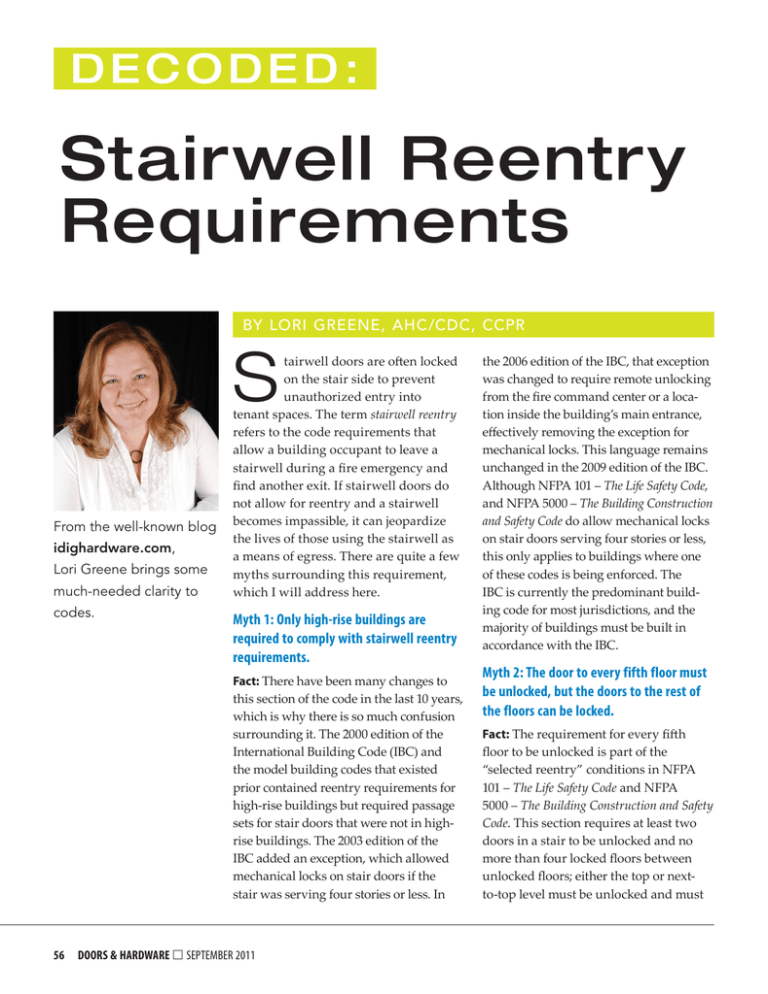
DECODED :
Stairwell Reentry
Requirements
By Lori GreenE, AHC/CDC, CCpr
S
From the well-known blog
idighardware.com,
Lori Greene brings some
much-needed clarity to
codes.
tairwell doors are often locked
on the stair side to prevent
unauthorized entry into
tenant spaces. The term stairwell reentry
refers to the code requirements that
allow a building occupant to leave a
stairwell during a fire emergency and
find another exit. If stairwell doors do
not allow for reentry and a stairwell
becomes impassible, it can jeopardize
the lives of those using the stairwell as
a means of egress. There are quite a few
myths surrounding this requirement,
which I will address here.
Myth 1: Only high-rise buildings are
required to comply with stairwell reentry
requirements.
Fact: There have been many changes to
this section of the code in the last 10 years,
which is why there is so much confusion
surrounding it. The 2000 edition of the
International Building Code (IBC) and
the model building codes that existed
prior contained reentry requirements for
high-rise buildings but required passage
sets for stair doors that were not in highrise buildings. The 2003 edition of the
IBC added an exception, which allowed
mechanical locks on stair doors if the
stair was serving four stories or less. In
56 DOORS & HARDWARE £ September 2011
the 2006 edition of the IBC, that exception
was changed to require remote unlocking
from the fire command center or a location inside the building’s main entrance,
effectively removing the exception for
mechanical locks. This language remains
unchanged in the 2009 edition of the IBC.
Although NFPA 101 – The Life Safety Code,
and NFPA 5000 – The Building Construction
and Safety Code do allow mechanical locks
on stair doors serving four stories or less,
this only applies to buildings where one
of these codes is being enforced. The
IBC is currently the predominant building code for most jurisdictions, and the
majority of buildings must be built in
accordance with the IBC.
Myth 2: The door to every fifth floor must
be unlocked, but the doors to the rest of
the floors can be locked.
Fact: The requirement for every fifth
floor to be unlocked is part of the
“selected reentry” conditions in NFPA
101 – The Life Safety Code and NFPA
5000 – The Building Construction and Safety
Code. This section requires at least two
doors in a stair to be unlocked and no
more than four locked floors between
unlocked floors; either the top or nextto-top level must be unlocked and must
allow access to another exit, the doors
allowing reentry must be marked as
such, and doors not allowing reentry
must have signage that indicates
the closest unlocked door in each
direction. Again, this only applies to
buildings where one of these codes
is being enforced; the IBC does not
include the selected reentry option. I
have only seen selected reentry used
on one project that I have specified,
and in my opinion, the codes were
being creatively applied in that case.
Myth 3: A fail-safe electric strike can
be used on a stair door to provide
reentry.
Fact: Stair doors providing reentry
must have a fail-safe lock or fail-safe
exit device trim that unlocks the
lever handle upon fire alarm/power
failure but does not unlatch the
door. A fail-safe electric strike will
not maintain the positive latching
required for fire-rated doors, and
the pressure from a fire could push
the door open, allowing smoke and
flames to enter the stairwell. The IBC
specifically states that stair doors
must unlock “without unlatching.”
Myth 4: The stairwell reentry requirements state that stair doors must
unlock automatically upon fire alarm.
Fact: There is a slight distinction
between codes, but the IBC states
that the stair doors must be “capable
of being unlocked simultaneously without
unlatching upon a signal from the fire
command center, if present, or a signal by
emergency personnel from a single location inside the main entrance to the building,” while NFPA 101 states that “an
automatic release that is actuated with
the initiation of the building fire alarm
system shall be provided to unlock all
stair enclosure doors to allow re-entry.”
The same type of hardware—fail-safe
locks or fail-safe exit device trim—is
used in either case, but the fire alarm
interface will be different. Please note
that there are additional requirements for two-way communication
in the stairwell when stair doors do
not allow free access at all times.
Myth 5: Both sides of a stair door can
be locked as long as the door unlocks
upon fire alarm.
Fact: I can’t count the number of
times an architect or end user has
asked me to specify hardware for
Code
Section
Mechanical Locks
Selected Reentry
Electric Locks
NFPA 101
7.2.1.5.7
Allowed on stairs
serving four
stories or less
Yes, refer
to code
Automatic release
actuated by the
fire alarm system
NFPA
5000
11.2.1.5.2
Allowed on stairs
serving four
stories or less
No
Automatic release
actuated by the
fire alarm system
IBC 2009
1008.1.9.10
and
403.5.3
No
Unlocked by signal
from fire command
center or location
inside building
main entrance
Not allowed
IBC 2006
1008.1.8.7
and 403.12
Not allowed
No
Unlocked by signal
from fire command
center or location
inside building
main entrance
IBC 2003
1008.1.8.7
and 403.12
Allowed on stairs
serving four
stories or less
No
Unlocked by
signal from fire
command center
Cook County Administration Fire:
On October 17, 2003, a fire started in a supply room on the 12th floor of the
35-story Cook County Administration Building in Chicago’s Downtown Loop.
The fire was relatively small, but the supply room was adjacent to one of the
two stairwells in the building that employees could use to evacuate during
emergencies. Responding to the fire with 135 firefighters and paramedics and
45 pieces of equipment, the Chicago Fire Department successfully contained
and extinguished the fire, but six civilians died from smoke inhalation. To
attack the fire, firefighters opened a door that connected the supply room to
the building’s southwest stairwell, giving them access to the flames, but also
letting smoke escape into the enclosed stairway. Simultaneously, workers
were attempting to evacuate the building down the same stairwell, where
smoke was now rising as if in a chimney. When the evacuees turned back to
exit the smoke-filled stairwell, they found that the doors back into their offices
were locked. Luckily an employee on the 27th floor had placed a doorstop in
the stairwell door, allowing many of the trapped people to escape the smoke.
After the fire was contained, however, firefighters found the bodies of 13
workers who did not make it up to the 27th floor. Fire department personnel
revived seven of the victims, but the remaining six suffocated in the stairwell.
September 2011 £ DOORS & HARDWARE 57
a door that is locked all the time
except during a fire alarm. If a door
is a required egress door, there are
very limited applications that would
allow this—NFPA 101 lists exceptions for certain existing occupancies, buildings permitted to have a
single exit, and certain healthcare
and detention/correctional occupancies. Most stair doors must allow
free egress from the non-stair side
at all times, and if there is a need to
limit egress, the two options would
be delayed egress hardware, which
delays egress for 15 seconds, or an
alarm to discourage use of the door.
Note that delayed egress locks are
not allowed in every occupancy
type, and there are additional code
requirements for doors equipped
with delayed egress locks.
Myth 6: Stair discharge doors opening to the exterior must unlock automatically upon fire alarm to
allow firefighter access to the stair.
Fact: The IBC specifically states
that “stairway discharge doors shall be
openable from the egress side and shall
only be locked from the opposite side.”
There is no requirement in the IBC or
NFPA 101/5000 for the exterior doors
to automatically unlock and provide
firefighter access, although it may be
required by some local jurisdictions.
Unlocking these doors automatically
upon fire alarm would impact the
building’s security, and there are
other ways for firefighters to gain
access. If remote release of the stair
discharge doors is required by a local
jurisdiction, I would highly recommend that these doors be controlled
by a switch at the fire command
center, rather than unlocked automatically upon fire alarm.
Stairwell reentry is an important
feature of life safety, and the requirements are often misunderstood or
stair doors modified after the building is completed. With proper attention and education, tragedies like the
death of six people in Chicago’s Cook
County Administration Building
(2003) may be averted.
About the Author: Lori Greene, AHC/CDC,
CCPR has been involved in the door and hardware industry since 1986. She is currently the
Specification Team Lead for Ingersoll Rand
Security Technologies. Lori holds a degree
in Architecture and Building Engineering
Technology from Vermont Technical College and
is a member of the NFPA and ICC.
Reprinted with permission from the September 2011 issue of Doors & Hardware magazine.
Copyright ©2011 by The Door and Hardware Institute. All rights reserved. Reprints available with
written permission from the Publisher. The Door and Hardware Institute, 14150 Newbrook Drive,
Suite 200, Chantilly, VA 20151-2232; 703/222.2010; Fax: 703/222.2410; www.dhi.org.
September 2011 £ DOORS & HARDWARE 59



